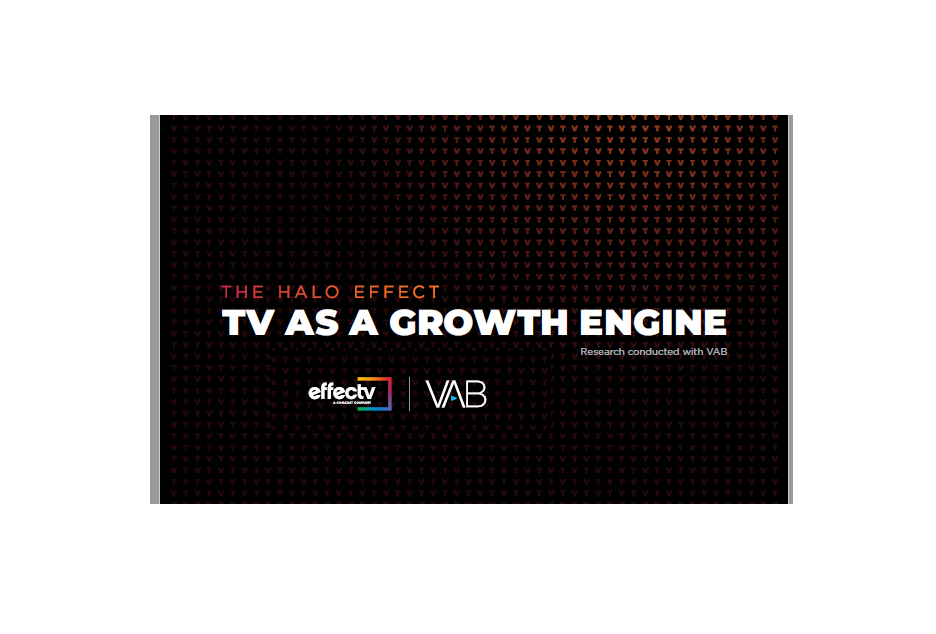Halo Effect 3's Lesson: TV Delivers Longer-Lasting Digital Life for Brand Advertising

It's a wrap for "The Halo Effect," the trilogy of explorations into television's impact on consumer relationships with brands from Comcast's Effectv unit. When it comes to this concluding study, the results appear to be the most expansive and impactful of all.
For the first two "Halo" papers, circulating earlier this year, Effectv's goal was learning how TV advertising drives brand awareness among viewers, then discovering how much TV drives engagement to online sites where additional brand information is available. In this last and latest effort, in partnership with VAB, an insights-driven organization dedicated to answering marketers' toughest questions , the focus turns to when in their existence products and services turn to TV campaigns to boost results, as opposed to other media.
"We wanted to understand how does TV help brands at different life stages," observes James Rothwell, vice president, global agency, brand and industry relations for Comcast's Effectv and FreeWheel operations. "Historically, brands have waited to invest in TV until they (reach) a certain revenue level of maturity before they feel it's the right time to dive into TV. On the flip side, TV has never been more accessible. It's never been more inclusive, in terms of being able to use all the technology and data at your fingertips to get strategic and surgical about the way you use it."
More specific, this "Halo" undertaking explored the behavior of direct-to-consumer (DTC), the fast-evolving universe of merchandise and services that encompass various categories from fitness to insurance. Companies like Wayfair and NerdWallet are top examples of direct-to-consumer ventures that share a common business-building strategy—advertise first on social media, then expand to podcasts and out-of-home campaigns, and finally linear TV commercials. "It's a very fascinating, digital native, performance-based and performance-obsessed (arena). -Our research has shown it -typically takes several years until they're ready to launch their first TV campaign," reveals Jason Wiese, VAB's senior vice president and director of strategic insights.
With VAB's resources, the study checked out recent use of linear TV campaigns among 190 brands. All but 50 were direct-to-consumer, with pharmaceutical, apparel, financial services and smart TV-distributed content among the categories represented. Two key conclusions: both participating DTC and non-DTC brands saw their unique online visitors jump by double-digits within the first month of launching their TV campaign. What's more, brands in the marketplace for three years or less experienced the largest visitor increases.
"The growth was compounded where there was a sustained TV strategy," adds Rothwell. "If you're continuously on-air, you continue building your business and your awareness. You're legitimizing your brand as a household name."
Among these companies, "they saw it almost like a light switch," Wiese continues. "When they started running (campaigns) on TV, they saw their traffic go up, and the younger brands saw much higher engagement, a much higher percentage increase in web traffic."
Within the non-DTC company group, younger brands spent more aggressively on TV campaigns and maintained a consistent level of visibility. Older brands hit the TV ground running, then leveled off their spending sightly, "counting on their established awareness in the market," Rothwell explains.
Along the way, DTC and non-DTC advertisers alike learned they didn't have to spend a fortune on TV commercials to achieve their goals. "They didn't have to go all in and have a $50 million campaign," he continues. "You just need a few thousand dollars, be creative and use targeting."
Wiese suspects that over time, advertisers will lean in the direction of multi-platform TV spending, with ad-supported content circulating through smart TV products increasing their share of the spending. "There's still a lot of room there to grow," he says. "The results will help us assemble marketing strategies for various advertisers. It's all about informing and educating marketers of the possibilities, then also show the outcomes. When TV works for a brand, they don't wait a year or two years to reinvest. They can move at a moment's notice. The dollars will increase pretty quickly."
"If we can bring a lot of these DTC brands into the ecosystem, more innovation and more different ad experiences will happen," Rothwell insists. "Different options for engagement will naturally occur. How do we make the TV screen more interactive and engaging? That's where I see a huge amount of excitement and opportunities."
To access the full paper, “The Halo Effect: TV As A Growth Engine”, please click here.
Click the social buttons to share this story with colleagues and friends.
The opinions expressed here are the author's views and do not necessarily represent the views of MediaVillage.com/MyersBizNet.


